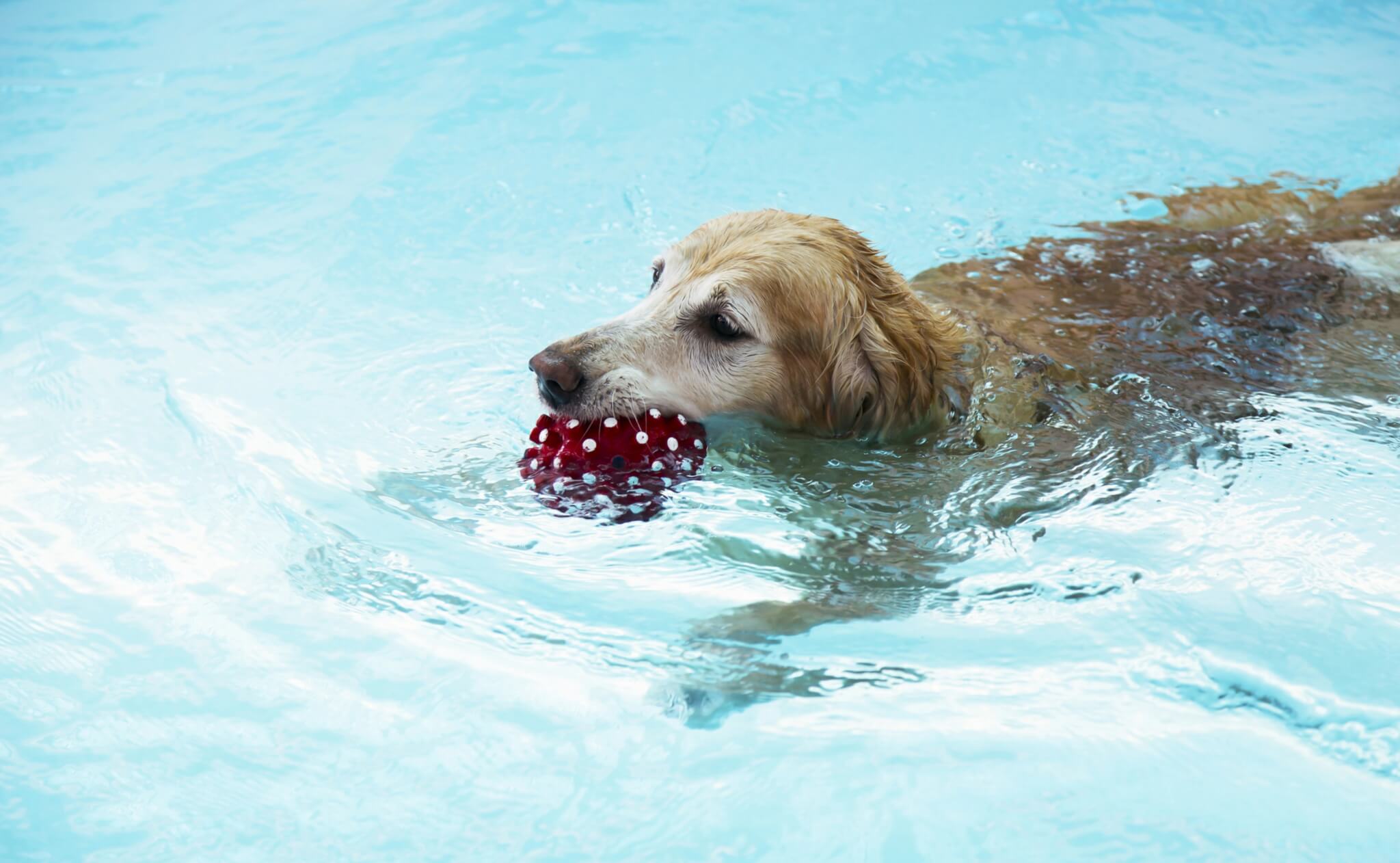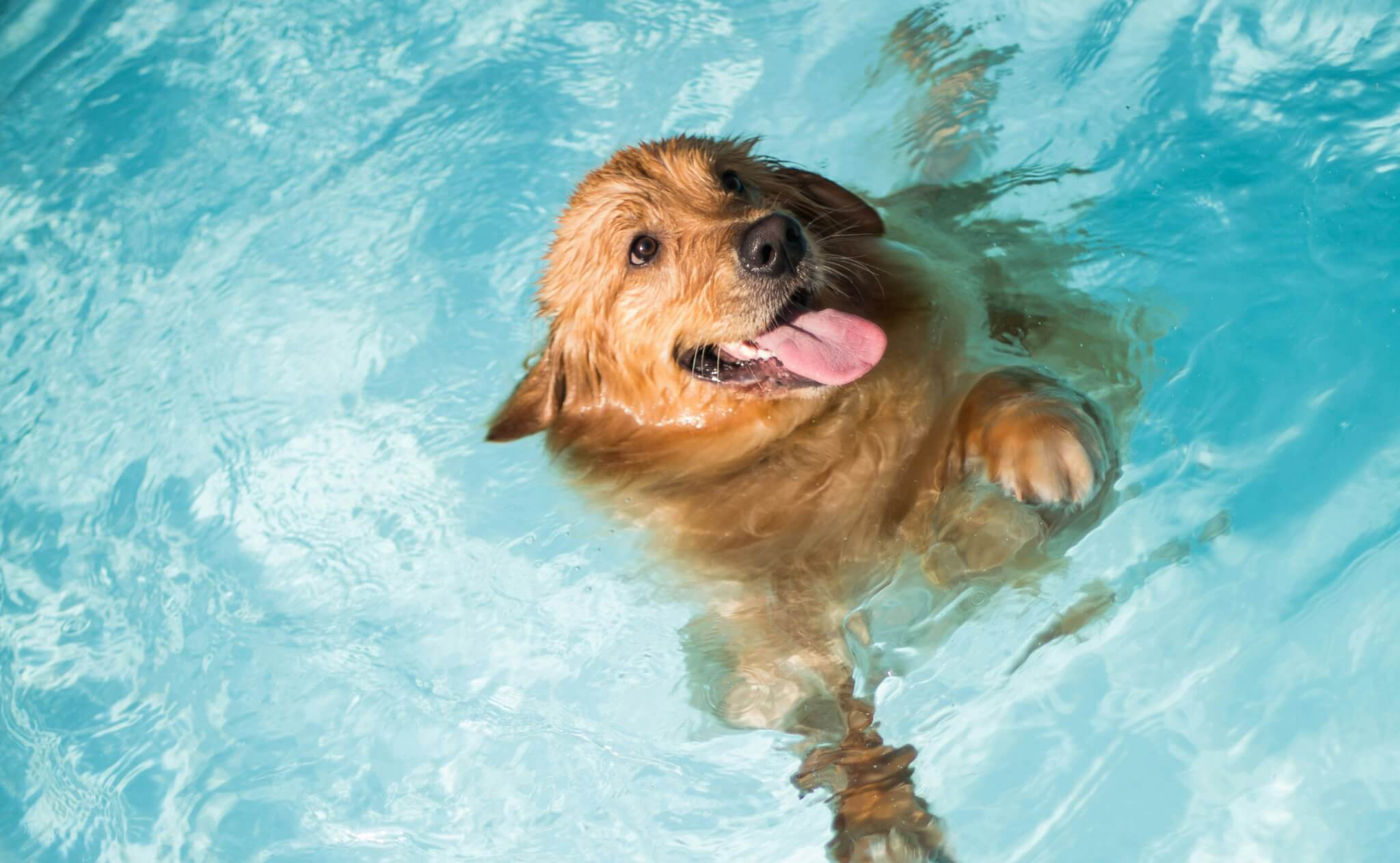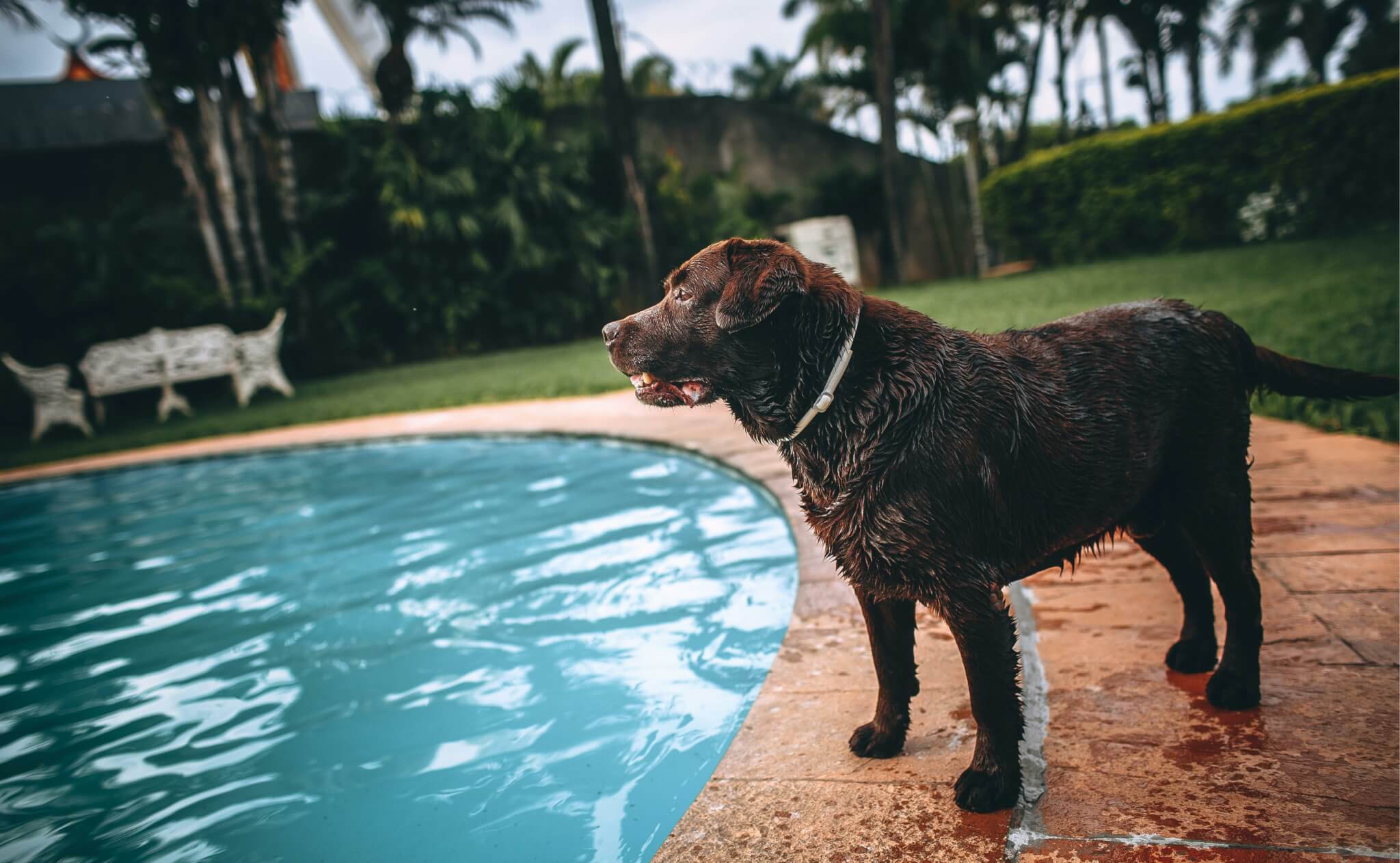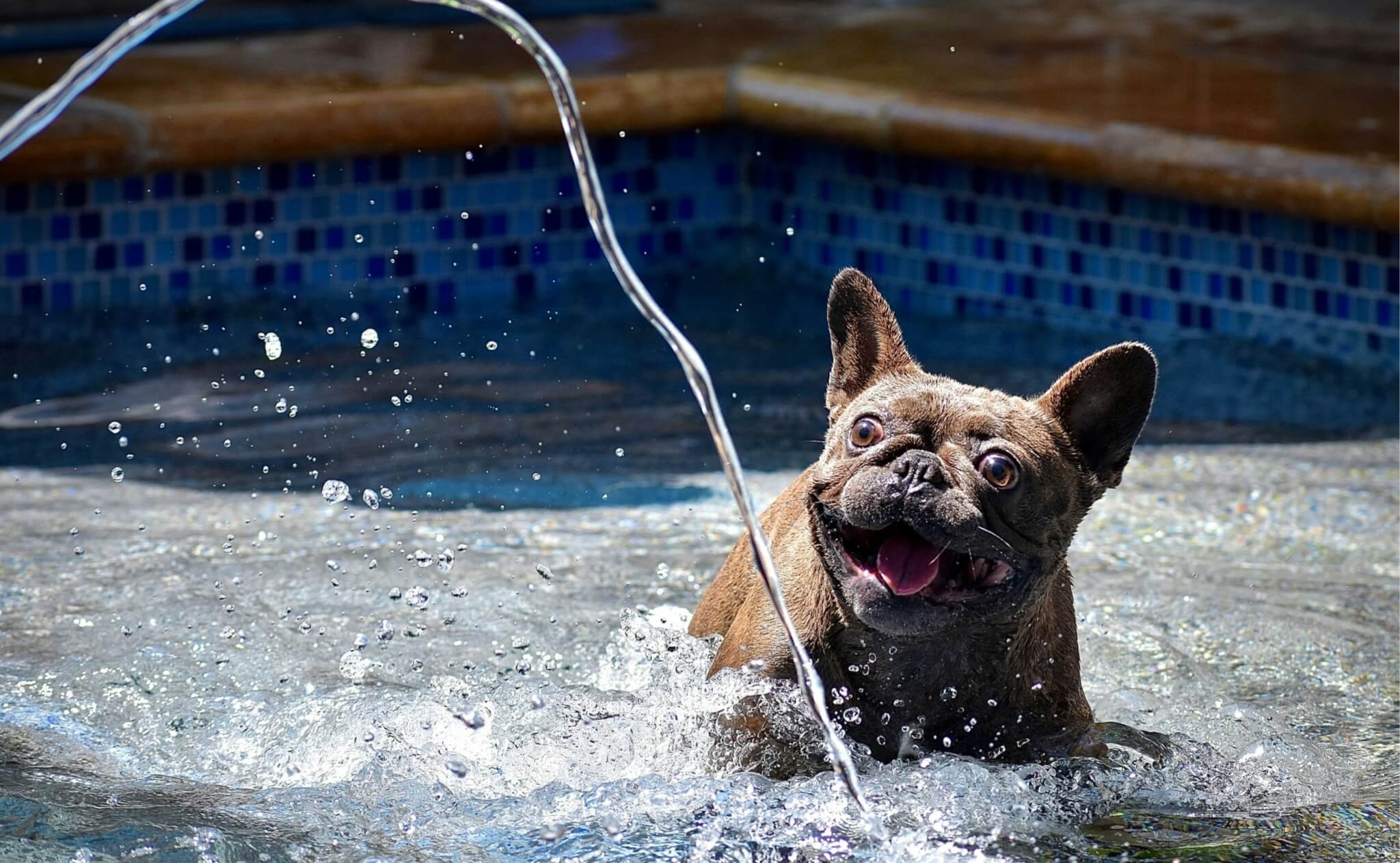
When the summer sun is blazing, there’s nothing more refreshing than jumping into a cool pool—and our dogs often feel the same way. Whether it’s splashing on the steps, paddling alongside their humans, or simply lounging on a float, dogs can enjoy the water just as much as we do. But many pet parents pause before letting their pup dive in, wondering: Is it safe for dogs to swim in chlorinated pools?
In this blog post, we’ll explore everything you need to know about pool safety for dogs, from chlorine levels and potential risks to safety tips, pool hygiene, and which dogs may need to stay dry. Let’s make sure you and your pup can enjoy pool time safely all summer long.
Related: How to Teach Your Dog to Love the Water and Swimming
Why Dogs Love Swimming
Just like people, dogs are drawn to water for play, relief from heat, and exercise. Swimming is a low-impact activity that builds muscle strength, improves cardiovascular health, and offers mental stimulation. For some breeds—like Labradors or Portuguese Water Dogs—it’s instinctual. Others learn to love it with positive experiences and support.
That said, before you let your pup dive in, you need to ask: Is it safe for dogs to swim in chlorinated pools?

What Is Chlorine and Why Is It in Pools?
Chlorine is a chemical used to kill bacteria, algae, and other contaminants in swimming pools. It keeps the water safe for humans by preventing the spread of waterborne illnesses. In most pools, chlorine is added in controlled amounts and kept within a target range (typically 1.0–3.0 ppm for residential pools).
But what about our four-legged friends? Is it safe for dogs to swim in chlorinated pools that meet human standards? The answer is: generally yes, but it depends on the dog and how the pool is maintained.
What Are the Risks of Chlorinated Pools for Dogs?
While a properly maintained pool is not likely to harm your dog, there are still risks to be aware of. To fully answer the question is it safe for dogs to swim in chlorinated pools, we need to look at possible side effects and safety issues:
-
Skin and Eye Irritation
Chlorine can cause dryness, redness, or itchiness, especially in dogs with sensitive skin. Some dogs may experience eye irritation or tear staining after swimming.
-
Ear Infections
Moisture from swimming—especially in floppy-eared breeds—can lead to bacterial growth and ear infections if not dried properly after pool time.

-
Ingesting Pool Water
If your dog tends to lap up water while swimming, this can be a concern. While small amounts of chlorinated water are usually not harmful, ingesting too much can lead to gastrointestinal upset or even chlorine poisoning in extreme cases.
-
Dry Coat or Damaged Fur
Frequent exposure to chlorinated water can strip natural oils from your dog’s coat, leaving it brittle or dull.
So, is it safe for dogs to swim in chlorinated pools? Yes—but knowing these risks helps you prepare and prevent problems before they start.
What If My Dog Drinks Pool Water?
It’s not unusual for dogs to drink from the pool while swimming. A few sips usually won’t cause any issues. However, large amounts can lead to:
- Nausea or vomiting
- Diarrhea
- Lethargy
- Electrolyte imbalances (in very rare cases)
If you notice your dog drinking excessively from the pool, redirect them to a fresh bowl of water nearby. Keeping your dog well-hydrated before and after swim sessions is one of the simplest ways to protect their health.
So again—is it safe for dogs to swim in chlorinated pools? It is, as long as you monitor their behavior and water intake.

How to Make Chlorine Pools Safer for Dogs
If your dog loves to swim, here are a few ways you can make your pool dog-friendlier:
- Rinse Before and After: Giving your dog a quick rinse before swimming removes dirt and oils that can react with chlorine. Rinsing off after swimming helps prevent irritation.
- Dry the Ears: Use a clean towel to dry your dog’s ears thoroughly, especially if they have floppy ears prone to holding moisture.
- Keep Chlorine Levels Stable: Avoid “shocking” the pool with chemicals just before your dog’s swim. Let levels stabilize before letting them in.
- Supervise Closely: Always watch your dog while they swim—just like you would with a child.
- Provide Breaks and Shade: Let your pup rest in the shade between swims to avoid overheating or overexertion.
All of these tips help reinforce the answer: Yes, it is safe for dogs to swim in chlorinated pools—if you take precautions.

Dog Swimming Safety Basics
Safe swimming isn’t just about water quality—it’s also about preparation and behavior. Here are some foundational dog swimming safety guidelines:
- Use Pet Pool Ramps or Steps: Make sure your dog has a clear way to get out of the pool. Not all dogs can find the exit on their own.
- Teach Them Slowly: Introduce your dog to water gradually. Don’t throw them in or force them to swim.
- Use a Canine Life Vest: Especially for puppies, senior dogs, or weak swimmers, a floatation vest can be a lifesaver—literally.
- Trim Nails Beforehand: Long nails can tear liners or hurt your dog if they panic in the water.
- Avoid Overcrowding: Too many dogs or humans can cause anxiety, especially for more timid dogs.
Following these safety steps makes it easier to confidently answer: Is it safe for dogs to swim in chlorinated pools? Yes—with preparation, supervision, and the right tools.

What Dogs Should Not Swim in Chlorinated Pools?
While most dogs can swim safely with supervision, some dogs may not be ideal candidates for chlorinated pool fun. These include:
- Senior Dogs: They may struggle with fatigue, arthritis, or water anxiety.
- Flat-Faced Breeds (Brachycephalics): Pugs, bulldogs, and boxers often have trouble breathing, especially during exertion.
- Dogs with Skin Conditions: Chlorine may worsen dry skin or hot spots.
- Small Breeds or Puppies: They can chill quickly or tire easily.
- Dogs Who Drink Excessively: If your dog compulsively drinks pool water, it’s best to avoid unsupervised swim sessions.
So while the general answer to “is it safe for dogs to swim in chlorinated pools” is yes, for these pups, extra caution—or dry land activities—may be safer.

Swimming Pool Dangers Beyond Chlorine
Chlorine isn’t the only thing to be cautious about. Consider these other pool-related hazards:
- Slippery Pool Decks: Dogs can slip and hurt themselves running on wet surfaces.
- Unattended Pool Time: Drowning can happen, especially if the dog falls in and can’t find the exit.
- Ingested Pool Toys: Swallowed toys or parts can become choking hazards or cause blockages.
- Algae and Debris: Unmaintained pools may harbor bacteria or toxic algae, especially if the pool isn’t balanced or cleaned regularly.
Always supervise your dog and keep your pool in good condition to avoid these dangers.

How to Maintain Pool Hygiene When Dogs Swim
Allowing dogs in your pool will increase your maintenance load slightly—but it’s manageable. Here’s how to stay on top of it:
- Brush and Skim Daily: Remove fur and debris
- Clean the Filter More Often: Dog hair can clog filters quickly
- Use Enzyme Cleaners: They help break down organic material (like fur and drool)
- Maintain Chemical Balance: Regularly check chlorine and pH levels
- Rinse Dogs First: Keeps the water cleaner longer
Proper pool hygiene makes it easier to say yes to the question: Is it safe for dogs to swim in chlorinated pools? A well-maintained pool and a clean pup make all the difference.

Conclusion: Is It Safe for Dogs to Swim in Chlorinated Pools?
So, is it safe for dogs to swim in chlorinated pools?
Yes—with supervision, proper pool maintenance, and a few safety precautions. Most healthy dogs can enjoy a dip in a clean, balanced chlorine pool without issues. However, every dog is different. Some may love the water, while others may be better off with a shaded lounge chair and a cold treat.
By understanding the risks and taking steps to protect your pup, you can ensure that swimming remains a fun, safe, and healthy experience.
👉 Does your dog love to swim? Have you ever had concerns about letting them in a chlorinated pool? Share your experiences or questions in the comments—we’d love to hear from you!

 Common Sense and a Little Extra Care for the Dog Days of Summer
Common Sense and a Little Extra Care for the Dog Days of Summer Everything You Need to Know About Flying with Your Dog
Everything You Need to Know About Flying with Your Dog 6 Disaster Preparedness Tips to Keep Your Dog Safe
6 Disaster Preparedness Tips to Keep Your Dog Safe 5 Non-Edible Dangers for Dogs During the Holidays
5 Non-Edible Dangers for Dogs During the Holidays What To Do If Your Dog Eats Chocolate
What To Do If Your Dog Eats Chocolate






Leave a Reply